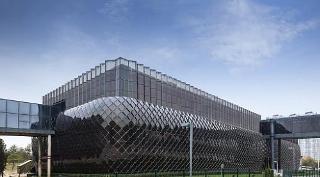Oct 28 2014
Today, Hanergy announced that the initial phase of its headquarters BIPV project is completed and generating clean, safe, and convenient power for its offices. Hanergy also declared that global technological integration and independent R&D have given Hanergy an edge as a supplier of comprehensive BIPV solutions—combining design, R&D, production, integration, construction, operation, and maintenance.
 BIPV project in Hanergy headquarters
BIPV project in Hanergy headquarters
When complete, the project's total installed capacity will be 3MW, and it will incorporate thin-film solar technology into curtain-walls, skywalks, flexible roof installations, and a carport. With the first phase's power generation capacity of 600kW, the headquarters can meet 20 percent of its electricity demand. After the second phase of the project is completed and generation capacity reaches 3MW, the headquarters will meet 100 percent of its electricity demand, allowing it to save the entire cost of its electricity bill, at 1.46 yuan per kWh, and also earn 0.42 yuan per kWh in distributed power subsidies. More importantly, the project will reduce carbon dioxide emissions by 2,500 tons, the equivalent of planting 140,000 trees or offsetting emissions from 780 cars.
The project introduces futuristic design elements while ensuring the original architectural integrity remains unchanged. The BIPV components on the exterior building walls adopt a design that resembles dragon scales by integrating thin-film components of different shapes, colors, and light transmittance rates. This creates a striking visual impact while optimizing aspects of lighting, sunshade, and ventilation. It is built with aesthetics in mind to highlight the infinite, novel design possibilities for green buildings.
Hanergy BIPV components are equipped with superior low-light performance, high temperature resistance, customizable shapes and colors, stable light transmittance, and improved malleability over traditional panels. As high-tech building materials, these components not only satisfy aesthetic demands, but are also certified as green and safe.
Speaking at the event, Dai Mingfang, Deputy Chairman and Chief Executive Officer of Hanergy Thin Film Power Group, introduced three of Hanergy's core technologies. They are: customized component manufacturing technology capable of various colors, specifications and light transmittance rates; diversified system integration technologies; energy conservation application technology that offers green energy solutions through BIPV. With these technologies, Hanergy is dedicated to providing customized BIPV solutions to modern buildings, the agriculture and animal husbandry industries, as well as municipal transportation facilities.
Hanergy provides customers with one-stop BIPV service—from market development, components R&D, architecture structure design, electrical design, and architectural thermal analysis, to system integration and standardization study.
Liu Min, Deputy Chairman of Hanergy Thin Film Power Group, said that BIPV is one of the most important ways thin-film solar power can be applied in our daily lives. He said that Hanergy, with its world-leading technology, would introduce to the public all the economic, environmental, and social advantages of green construction and BIPV installation.
In recent years there has been consistent growth in global energy consumption and ever-growing pressure on the environment. Architectural energy consumption accounts for about 30 percent of global consumption. Promoting BIPV in China will significantly improve building energy conservation and help ease the energy bottleneck there.
In the following five years, the applicable area for BIPV in China's urban areas will reach 1.79 billion square meters with an estimated electricity generation of 61.5 billion kWh. It will reduce 52 million tons of carbon dioxide, equivalent to planting 2.9 billion trees or offsetting the exhaust emissions of 16 million cars.